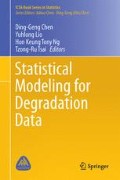Abstract
Accelerated destructive degradation testing is considered with the objective of reproducing high fatigue incidents for a severely nonlinear system in a lab environment. In the lab, a test specimen is mounted on servo hydraulic actuators which are then used to induce the same response in the system as was measured in field tests. Finding the inputs to the actuators that accurately induce the measured response in the system is crucial to the integrity of the testing procedure. The problem is an inverse problem, and often exhibits ill-posed characteristics. To this end a new method for system identification from time series data is developed and is shown to outperform current methods such as different variants of NARX and Hammerstein-Wiener models. From the results obtained it is concluded that an alternative method of data generation for accelerated destructive degradation on severely nonlinear systems in a lab context is required. Three methods are developed and tested on simulated data and it is shown that a prototype bootstrapping strategy is superior: using 400,000 data points generated by this strategy the input signals were predicted with mean square errors of 5.08e-4.
Access this chapter
Tax calculation will be finalised at checkout
Purchases are for personal use only
Notes
- 1.
Method 514.6 Annex A.
References
Agostinacchio M, Ciampa D, Olita S (2014) The vibrations induced by surface irregularities in road pavements–a MATLAB®; approach. Eur Transp Res Rev 6(3):267–275
Aguirre LA, Letellier C (2009) Modeling nonlinear dynamics and chaos: a review. Math Probl Eng. http://dx.doi.org/10.1155/2009/238960
Billings SA (2013) Nonlinear system identification: NARMAX methods in the time, frequency, and spatio-temporal domains. Wiley, New York
Burden R, Faires J (2005) Numerical analysis. Cole, Belmont
Crous J, Kok S, Wilke DN, Heyns PS (2016) An alternative approach to system identification. In: Proceedings of the 10th South African conference on computational and applied mechanics
Crous J, Kok S, Wilke DN, Heyns PS (2016, Submitted to Machine Learning) A scaling-rotation based approach to multi-target regression in high dimensional spaces as an alternative to the standard projection based approaches
Eksteen J, Heyns P (2016) An alternative update formula for non-linear model-based iterative learning control. Inverse Prob Sci Eng 24(5):860–888
Eksteen JJA (2014) Advances in iterative learning control with application to structural dynamic response reconstruction. PhD thesis, University of Pretoria
Golub GH, Van Loan CF (2012) Matrix computations, vol. 3. JHU Press, Baltimore Maryland.
Han X, Xie W-F, Fu Z, Luo W (2011) Nonlinear systems identification using dynamic multi-time scale neural networks. Neurocomputing 74(17):3428–3439
Hastie T, Tibshirani R, Friedman J (2009) The elements of statistical learning. Springer, New York
Ikonen T, Peltokorpi O, Karhunen J (2015) Inverse ice-induced moment determination on the propeller of an ice-going vessel. Cold Reg Sci Technol 112:1–13
Kerschen G, Worden K, Vakakis AF, Golinval J-C (2006) Past, present and future of nonlinear system identification in structural dynamics. Mech Syst Signal Process 20(3):505–592
Kugler DL, Kramer LL (2003) Accelerated destructive degradation tests: data, models, and analysis. Math Stat Methods Reliab 7:319
Leontaritis I, Billings SA (1985) Input-output parametric models for non-linear systems part I: deterministic non-linear systems. Int J Control 41(2):303–328
Leontaritis I, Billings SA (1985) Input-output parametric models for non-linear systems part II: stochastic non-linear systems. Int J Control 41(2):329–344
MIL-STD-810G (2008) Enviromental engineering considerations and laboratory tests. Department of Defence
Moon FC (2004) Chaotic vibrations: an introduction for applied scientists and engineers. Wiley-Interscience, New York
Pearson R (2003) Selecting nonlinear model structures for computer control. J Process Control 13(1):1–26
Petracconi C, Ferreira S, Palma E (2010) Fatigue life simulation of a rear tow hook assembly of a passenger car. Eng Fail Anal 17(2):455–463
Pillonetto G, Dinuzzo F, Chen T, De Nicolao G, Ljung L (2014) Kernel methods in system identification, machine learning and function estimation: a survey. Automatica 50(3):657–682
Schramm D, Bardini R, Hiller M (2014) Vehicle dynamics. Springer, Berlin/Heidelberg
Sirca G, Adeli H (2012) System identification in structural engineering. Scientia Iranica 19(6):1355–1364
Sjöberg J, Zhang Q, Ljung L, Benveniste A, Delyon B, Glorennec P-Y, Hjalmarsson H, Juditsky A (1995) Nonlinear black-box modeling in system identification: a unified overview. Automatica 31(12):1691–1724
Slotine J-JE, Li W et al (1991) Applied nonlinear control, vol. 199. Prentice-Hall, Englewood Cliffs
Smolders K, Volckaert M, Swevers J (2008) Tracking control of nonlinear lumped mechanical continuous-time systems: a model-based iterative learning approach. Mech Syst Signal Process 22(8):1896–1916
Strang G (2007) Computational science and engineering, vol. 1. Wellesley-Cambridge Press, Wellesley
Strang G (2007) Linear algebra and its applications, vol. 1. Cengage Learning, Boston Massachusetts.
Tarantola A (2005) Inverse problem theory and methods for model parameter estimation. SIAM, Philadelphia.
Author information
Authors and Affiliations
Corresponding author
Editor information
Editors and Affiliations
Rights and permissions
Copyright information
© 2017 Springer Nature Singapore Pte Ltd.
About this chapter
Cite this chapter
Crous, J., Wilke, D.N., Kok, S., (Din) Chen, DG., Heyns, S. (2017). On System Identification for Accelerated Destructive Degradation Testing of Nonlinear Dynamic Systems. In: Chen, DG., Lio, Y., Ng, H., Tsai, TR. (eds) Statistical Modeling for Degradation Data. ICSA Book Series in Statistics. Springer, Singapore. https://doi.org/10.1007/978-981-10-5194-4_17
Download citation
DOI: https://doi.org/10.1007/978-981-10-5194-4_17
Published:
Publisher Name: Springer, Singapore
Print ISBN: 978-981-10-5193-7
Online ISBN: 978-981-10-5194-4
eBook Packages: Mathematics and StatisticsMathematics and Statistics (R0)

